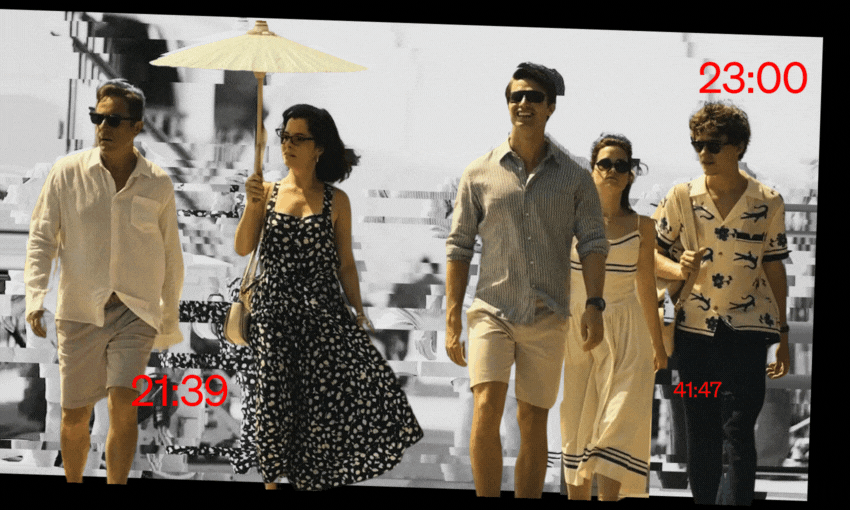After two and a half weeks, the Auckland Arts Festival comes to a close with another eclectic week. Sam Brooks reviews (with assistance from Shanti Mathias).
The headline show of the week was undoubtedly The Unruly Tourists, which has had more coverage than any opera I can think of in recent years. I reviewed the show here, and after a weekend of discussions with people who both had and hadn’t seen it, I feel pretty set in my view. It’s a fun show, one that didn’t necessarily deserve the controversy around it, and one that frames itself as the very thing that it critiques. The best thing I can say about the show is that I’ve heard more people talking about opera than ever before, and in more productive conversations than “oh, that’s not for me”.
The last weekend of the arts festival can be a brutal one for a show to debut – either people are exhausted from squeezing shows in, or they’ve just realised there’s a festival on and are scrambling to get to a show before it closes (although, anecdotally, the show people seemed to be scrambling to get to was The Picture of Dorian Gray).
The Chosen Haram, based on Edinburgh-born artist Sadiq Ali’s experience and interviews with members of the queer community who identify as (ex) Muslims, blends theatre, dance and acrobatics to explore those struggles. While initially appealing, and performed with gusto, the show ends up hitting familiar notes – the inevitable road from repression to hedonism to self-destruction. Even the imagery, while often gorgeous (especially the best use of translucent plastic I’ve ever seen) also treads a familiar road. While the Chinese poles are versatile tools, they carry the performers’ weight better than they carry the metaphors of the show, and I left feeling more illuminated than moved.
A highlight of the festival is the chance to see a work in development, one that will hopefully be picked up in a future festival. This year’s work in development was Mixtape for Maladies, a new show by arts laureate Ahi Karunaharan. While the framing is set firmly in the present day, it tells the story of a Sri Lankan family from the middle of the 20th century until they were forced to flee their homeland in 1990. A series of vignettes, interspersed with songs (the titular mixtape), the youngest of that family seeks to learn the story behind each of these songs, and what they mean to the family.
Even though this was a reading, it had the heft of a full performance, with a full ensemble of costumed performers, musicians and dancers carrying it across. It also had the heft of a dedicated community event, with many of the audience excited to see specific performers, and clearly, to see this story told. This is heavy stuff, but Karunharan’s script carries the story of this family, and it’s one that I really hope to see programmed in a future festival or mainstage programme.
Staff writer Shanti Mathias went along to see a performance from Eishan Ensemble, a Persian jazz fusion group, and found it to be a delightful puzzle. “The five group members played accordion, bass, percussion, saxophone and tar. The melodies were incredibly textured; I felt myself watching closely, trying to pick out the exact moment a motif moved from the accordion to the sax. The group was mainly performing tar player Hamed Sadeghi’s original compositions, with significant space for improvisation within each song.
“The thrilling thing as an audience member is that the performers are so well practised and fluid that the only indication that some of this is being improvised is the tight lines of attention between each member of the ensemble as they waited for each other to pick up what they were putting down. I know that a lot of jazz musicians can do this and yet it was amazing to me.
“Between songs, the friend who was attending with me said ‘it sounds like a film noir soundtrack’. Yes! It also sounded like bright threads being woven into a lush carpet, like waiting for stars to appear while standing on a rooftop, like doing cartwheels over old stone. In other words: beautiful, thrilling, fun – perfect for Auckland Arts Festival’s Spiegeltent with its red fabric and shining mirrors.”
I wasn’t expecting to close my festival out with a Sunday morning showing of Samulnori! The Power of K-Rhythm, a concert of traditional Korean music played with four instruments (kkwaenggwari, jing, janggu and buk) but I’m extremely glad I did. The show, which also played around the city, was the most fun I’ve had at the festival – and the energy of the performers clearly being so stoked to share their form with us was infectious. It was visceral, it was joyous, and it reminded me that this is the ideal arts festival experience: something that you go along to, just because you can, and your world view is opened a little wider as a result.
And with that, I’m going to include a little plea. Something like the Auckland Arts Festival only exists because the city supports it, and without it, our city is weaker. I was lucky enough to see 13 shows throughout the festival (and I wished I’d had enough time or space to get along to more visual art) and while I’m exhausted, I also feel full to the brim in the best way.
I didn’t necessarily love everything I saw, but that’s not the point of an arts festival. The point of an arts festival is to bring culture to audiences, to platform artists and their craft, and to draw the world a little bit closer together. That’s not just the remit of an arts festival, though, that’s the remit of the kind of arts, culture, community and sports programmes that are at risk of losing council support. Tell the people in charge that you care about these things, that they’re important.



